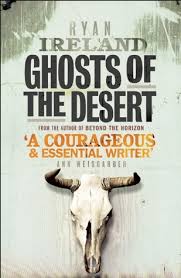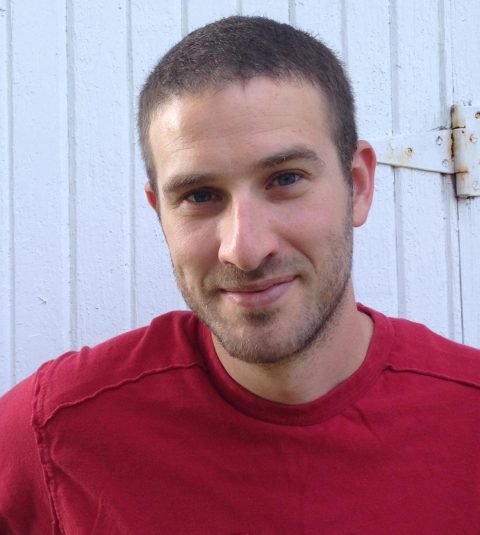Ryan Ireland is reading for SmokeLong Quarterly the week of May 23-29. The author whose story he selects for publication in SmokeLong Weekly and again in SmokeLong Quarterly Issue 53, will receive a hard copy of Ghosts of the Desert. Read on to learn more about Ryan’s forthcoming novel, his thoughts on westerns, and what he looks for in good fiction.
One of the things I found really provocative about Ghosts of the Desert is that it deliberately subverted my expectations for a western: there were no characters I could point to in the immediate action that deserved to wear a white hat. I’m trying to be a little vague because the book hasn’t come out yet in the US, but what advice would you give a writer trying to figure out how to get readers to engage with a character whose morals—to be polite—are extremely questionable?
No need to be polite! The characters in Ghosts of the Desert are a parade of depravity and immorality. They commit heinous crimes and revel in their inhumanity. So, yeah, how do I get people to root for them? I don’t. But people will read anyways. We have a fascination with the disturbing, the macabre, the seemingly bottomless pit of evil we seem capable of producing. We want to know what makes someone tick. It’s easy to look at the behavior of serial killer and say, “He’s just crazy!” What fascinates people is the serial killer truly believing that God communicated with him through a labrador retriever and the dog said, “Kill strangers and store their bodies in your basement.” People love these stories. The focus doesn’t necessarily have to be on the grotesque; sometimes it can just be the oddities of a subculture so unlike our own. When the members of the Heaven’s Gate cult committed mass suicide I was thirteen years old. The news loved that story. Sure, they covered the grisly side of it—decomposing bodies and such. But the public wanted to know more about the practices and the intricacies of the cult’s brand of crazy. Why did they all have five dollar bills in their pockets? Why did they all have purple cloths over their face? What was the obsession with Hale-Bopp Comet? Did they really base their beliefs off Star Trek? Years later I don’t recall the name of their leader, but I could tell you they all wore matching Nike sneakers. There wasn’t a sympathetic character in the whole situation, but we ate up the story anyway. We read in an effort to understand. Authors must have faith in their readers; give the reader something hard to digest and trust them to chew on it, even if it is displeasing to the palate.
A main thematic issue of your book feels like perception. Norman (the protagonist) and Jacoby (God, I’m not even quite sure how to categorize him: antagonist, mentor, father-figure, maniac) discuss what is seen, what is known and unknown at different points. Sometimes they seem like mirrors. Each just has a slightly different angle into the novel’s room. What was the process like for creating these characters?
I half-jokingly tell my agent that Ghosts is a Western where the characters sit in a grad school seminar. I wrote most of Ghosts’ long conversations based on the meandering, amorphous, at times outlandish debates that occurred in my PhD seminars. Jacoby is a professorial figure—always present in the mind and looming over all conversations—the sagely maniac, the charismatic cultish leader. He was actually easy to write; give him a blank sheet of paper and he could fill it up with musings and anecdotes and monologues. Trying to contain Jacoby and hold the reader’s interest—that was the problem (again, like  a grad school seminar). Enter Norman, our main character—the student.
I had no idea Norman would himself be such a terrible person. I had no backstory for him at the onset, but figured there would be one. I didn’t plan for flashbacks or plot out his criminal history. But as the situations formed themselves and Jacoby did his own brand of psychoanalytic feedback with Norman, the story fleshed itself out. Every day, when I sat down to write, I wondered what I would discover about Norman’s past. As I wrote I was more repulsed by him and at the same time wondered how far down this abyss went.
a grad school seminar). Enter Norman, our main character—the student.
I had no idea Norman would himself be such a terrible person. I had no backstory for him at the onset, but figured there would be one. I didn’t plan for flashbacks or plot out his criminal history. But as the situations formed themselves and Jacoby did his own brand of psychoanalytic feedback with Norman, the story fleshed itself out. Every day, when I sat down to write, I wondered what I would discover about Norman’s past. As I wrote I was more repulsed by him and at the same time wondered how far down this abyss went.
If you were going to teach a class on the Western as Literature, what short stories, books, movies, etc. would you assign?
I like the way you ask this question. At this point the Western is so entangled with other media—especially film—that it is hard to study it as solely a print genre. The Western is heavy in tradition; it has stories that need to be told and retold. Really a class in the Western is a class in how stories are passed down and changed over time because they’ve always existed in popular form—folk songs, dime novels, films, TV series. First I would tackle the Western as part of larger tradition—one that borrows heavily from other cultures. Perhaps the best example of this is Akira Kurosawa’s Seven Samurai and how it was turned into John Sturges’ The Magnificent Seven. America loves to claim the Western as its own, but, like the West itself, it is built by many different cultures. And I like the way we tell the same stories over and over again; I like the way they change.
A more modern example of this is Charles Portis’ True Grit. His book is fascinating because he adopts the view of a young female in the West—something not often done at the time (or since). If you pair it up with the John Wayne classic and then the Coen brothers’ remake, there are some fascinating overlaps and omissions. I love that the Coen’s reinstated the frame narrative of Portis’ novel—that the story belongs to Maddie and years of reflection color her experience. We don’t see that in the John Wayne film. But if we study all three True Grits as a lineage, it tells us something about our present culture—where we see women in the genre, what storytelling devices are important.
Most Fridays I take a lunch break from my job at the library and walk down to a cafe located inside of a rare and used bookstore. The guy who manages the place, Lawrence, has a great collection of Americana and early Westerns. I picked up a book about Calamity Jane the other day, written in 1920. Calamity Jane is an interesting figure because people tend to morph her into current contexts. In this 1920 book, she is portrayed as a suffragette, fighting for women’s rights. A book published twenty years later might portray her as a war hero. Twenty more years—deep into the 1960s—and she might be a counter-culture figure. In a class on Westerns I think it’s important for students to find these forgotten books that created myths and legends and put them into context. Find any larger-than-life Western figure—Billy the Kid, Butch Cassidy, Annie Oakley—and their biographies, the stories about them change with our current times.
Reading list: Ann Weisgarber, Sherman Alexie, Annie Proulx, Claire Vaye Watkins, Edward Abbey, Ron Hansen .
Films: El Topo, McCabe and Mrs. Miller, Unforgiven, No Country for Old Men, Deadwood (TV series), High Noon, Buck (documentary)
Other: Listen to Hank Williams, Johnny Cash, Patsy Cline; see how cowboys are represented in Midnight Cowboy, The Big Lebowski, and Mulholland Drive; study iterations of Western maps (~1840-1920) to see how it was shaped by commerce and imperialism
What can a writer do in their first paragraph to make you want to keep reading?
Provide a provocative image. It can be a bit of action or a memory, something unusual or beautiful or terrifying. It’s like a postcard—if the picture on the front grabs my attention, I’ll read the back.


 A SmokeLong Summer 24!
A SmokeLong Summer 24!